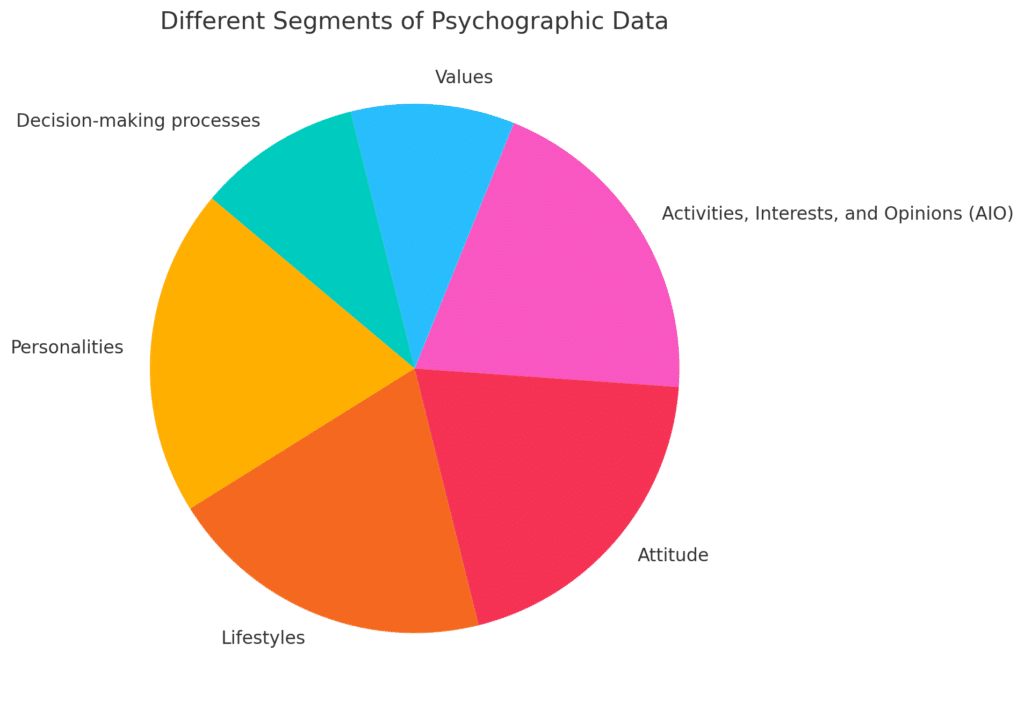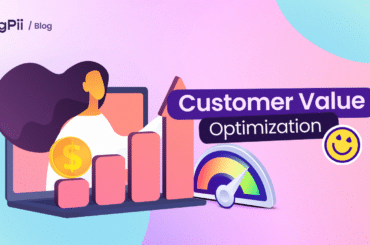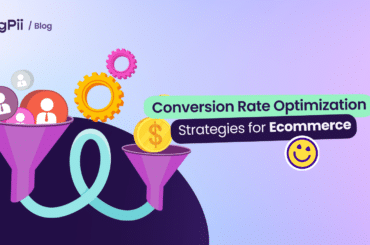– What is Psychographics?
Psychographics is a qualitative research method that gives you an idea about your customers’ psychological attributes like personality, goals, attitudes, beliefs, interests, and values.
You can think of it as one of the useful tools marketers use to hone and create impactful marketing messages.
If you know what your user is like, what he thinks of, and what he likes to do in his free time, you can create an offer that delights them.
In this article, we will take a deep dive into psychographics. After reading this article, you will be able to:
Collecting Psychographic Data (Psychographic Profiling)
When it comes to collecting psychographic data, it won’t be a walk in the park.
The best way to get the most accurate psychological data is to listen to your customers as much as possible.
You can do that in 4 major ways:
- Interview existing clients
- Analyze website analytics
- Use focus groups
- Analyze Public Spaces (Social Media, Forums, etc.)
- Send out surveys
Let’s start with interviewing customers.
Interview existing customers
Every marketer knows that if you want to make your brand resonate with your targeted audience, you need to speak their language and avoid using industry terminology.
And that’s why interviewing existing clients is such an important part of collecting not just their psychographic data, but the words they use to describe their pain points.
To interview clients, you’d need to have a reliable framework. Here at FigPii, we use Dr. Clay Christensen’s Jobs-to-be-done framework.
Suppose you want to collect psychographic data through interviews. What kind of questions you should ask customers? Well, that depends on the product or service, but you can always consider the following:
- What do you like to do in your free time?
- Do you like experiencing new things, or are you just interested in what you’re familiar with?
- Where is your dream holiday destination?
- Do you buy based on price, quality, or brand name?
- Where do you go for advice on which products to buy?
These questions are sufficient as a conversation starter, and you’ll have to drill deeper into the more interesting parts that your interviewee glances over.
Bit by bit, you’ll be able to piece together what they like, what they don’t, and what their psychological profile looks like.
But before going into the interview, you should be prepared; you can prepare by doing mock interviews to get yourself in shape.
Analyze website analytics
Analyzing website analytics means looking into the numbers behind your website. So, your website has to have an analytics tool. It can either be Google Analytics, Heap, Mixpanel, etc.
Google Analytics is good at many things; it’s even semi-good at giving you the demographics of your business, but at the same time, GA can’t use it alone to collect psychological data.
Use focus groups
Focus groups are an effective way to get psychological data because they focus on a small sample of people, thus giving you much more diverse answers.
It’s an effective way to have a bigger picture about your product or service early on, combine that with interviews, and you can drill deeper into what makes your customers tick and how they think.
Analyze Public Spaces (Social Media, Forums, etc.)
One of the best ways to know what your customers are like is to analyze their social presence.
You might want to start with social media by analyzing and profiling some people interacting with you or your competitors.
Two of my favorite places to do psychographic research are Facebook groups and Reddit.
Imagine being able to get into a community of people who are either using your product or your competitor’s. That’s what Facebook groups are all about, and here let me give you an example of just that is the “SEO Signals Lab“.
A post like that is a gem mine because of the amount of data that’s being shared, people commenting from their profiles, and there’s no easier way to reach them other than to just shoot them a message.
My second favorite place is Reddit, where people are eager to share their thoughts and give you everything you need on a silver platter. And one of my favorite subreddits has to be r/SaaS.
Here, people share their stories left and right without holding back.
It couldn’t be easier to talk to people and gather in social queues than at this point.
Customer Surveys
Last but not least, customer surveys: if you’re not utilizing customer surveys to your advantage, you’re missing out on a lot; we’ve written a blog about survey examples that you need to utilize to grow your business.
Surveys are used widely by marketers like you and me to get to know our customers. We try to ask questions to get them to open up to us and tell us what they think about our products; in that regard, they’ve proven successful.
But what about psychographic profiling? Are they any good? Well, yes, they’re; when you ask your customer an open-ended question, you give him the space to express himself.
So, what should you do if you want to launch surveys that help you segment your customers without getting lost?
First of all, start with a small segment of people. Your questions will vary depending on your goals from launching the survey, but you can ask them about their purchasing habits.
“What’s more important to you, price or brand? Could you tell us more about why you chose your answer?” this question could seem a bit simple, but the insights drawn from it are a gold mine.
Take your time and sort out the answers to these questions into categories, maybe into two main categories: one for people who choose the price and one for people who choose the brand.
Now dive deeper into the answers, and try to look for patterns to help you navigate through answers more quickly.
Repeat that for a bigger sample size and ask open-ended questions, that way, you’re more likely to get great results, then categorize and look for patterns.
What is Psychographic Segmentation?
Psychographic segmentation is the process of breaking down your customers into categories based on their physical characteristics, like goals, attitudes, beliefs, interests, and values.
Marketers use segmentation in day-to-day activities, from segmenting traffic using tools like Google Analytics or other analytical tools, and so on.
However, segmenting based on psychographics is much tricker because psychographics are qualitative and not quantitative, and you can’t push some buttons to get the data you’re looking for.
But that doesn’t mean it’s not doable; it just means you need to be a bit creative to get to what you’re looking for, and once you get your data sorted, you’ll find that it’s a gold mine of info.
So why is psychographics important in marketing? Why do we need psychographics if we have other kinds of data that can guide us?
Importance of Psychographic Segmentation
Knowing your customer is your 1st step to growing. I know of no other way around it personally, and that’s where psychographic segmentation comes into play.
Imagine that you’ve crafted a message and spent time on it, only to fall flat. That’s why psychographics is super important for us as marketers: we want to have the highest impact with each touchpoint we have with our customers.
Psychographic segmentation allows us to understand our customers better, thus saving us the time and effort we’d have spent trying to determine what motivates our customers.
It also allows us to identify growth opportunities we might not have noticed before by digging into our customers’ data and looking for connections, patterns, and other ways of knowing the “why behind their actions.
Types of Psychographic Segments 
Psychographics is tricky to categorize because we, as marketers, love to put everything we do in numbers or well-defined categories. Still, looking at psychographics, you won’t be able to do that.
So we rely on categorizations that other marketers have come up with, categories that, over the years, became the default go-to for the subject of psychographics.
These categories are:
- Personalities
- Lifestyles
- Attitude
- Activities, Interests, and Opinions (AIO)
- Values
- Decision-making processes
Personalities
A personality is the combination of characteristics or traits that make us unique on an individual level. It is what makes us who we are. While personality isn’t measurable, we have the “Big Five Personality Test,” which can give you a good idea of a person’s personality.
Those five characteristics {personality traits} are (agreeableness, openness, extraversion, conscientiousness, and neuroticism).
Agreeableness is the personality treat of putting others’ needs above your own, and these people love to help others be happy or excel at work.
Think of people who work at charities, giving their time and sometimes money to help others in need.
Openness is the personality treat of being generally open-minded to new ideas and concepts that you’re not familiar with.
Think of people who pick up a new book to read, visit an art gallery to see art they have never heard about, or travel to see other people’s cultures.
Extraversion is the personality treat of being an outgoer, and you’re always interested in meeting new people, lifting other people’s vibes, and actively seeking friendships and the company of other people.
Think of people who love attending parties and social events, are unafraid of public speaking, and are always positive.
Conscientiousness is the personality trait of a hard-working person; you are always careful when doing your work because you want it to be done without flaws.
Think of people who’re not easily distracted at work, who’re into doing stuff the right way even if it takes longer, and those who work smart and hard.
Neuroticism is a highly debated personality treat, so I will link some resources from which you can read more about it.
Lifestyles
A lifestyle is how a person lives his day-to-day life, what he does when he wants to relax, where he lives, what he does for a living, etc.
Lifestyles are a diverse topic to give an example of because no matter what you do, you’ll never cover them all.
There’s no agreed-upon categorization of lifestyles, which can be a blessing in disguise because you can customize your customers’ lifestyles based on your product, enabling you to create a highly detailed psychological segmentation of their lifestyles.
Attitude
Attitude is an important categorization because, as humans, the first thing that’s easily noticeable is our attitude and how we react to things.
Knowing how people react to your brand is what drives your brand forward and what causes people to be loyal to you.
A huge example of that is Apple and its consumers. Apple built a culture of class using its products that no other tech brand managed to do.
When you see an Apple device, you quickly associate it with quality, high price, brand name, etc., and people who own Apple devices usually act like they’re part of an elite family
Activities, Interests, and Opinions (AIO)
AIO sums up what your users spend most of their time doing outside your app or website,, which can include things they’re reading about and doing in their free time.
What matters the most when it comes to AIO is the idea that your user doesn’t spend all his time on your website or app, so you need to create multiple touch points with other things that interest your users to stay connected and relevant.
An example is the partnerships you usually see gaming companies do with influencers over Twitch or YouTube; they blast their logo 8 hours a day or more to an audience who likes playing video games but is also interested in consuming video media.
Values
Values are what you believe in and what defines your moral compass, your idea of right and wrong.
They’re crucial if you want to nail down your segmentation because humans are vastly different, and while some might love your products, others might hate them.
There’s not much to discuss with values because they can’t be theorized in a blog. I recommend reading “How People Tick” to learn more about human psychology.
Decision-making Processes
One of the most important things we as marketers have to figure out is what makes our customers buy from us and what brings them to our brands.
That’s pretty much what we look for when we segment our customers; we try to figure out patterns that make people buy from us and decipher their motivations.
Companies like Google know that very well and use it to their advantage. Google has built its entire search engine to help it make more sales through its ad platform.
Google trains its algorithm to know when we search with the intent of buying, so it serves us the right ads.
Examples of a Psychographic Segmentation
One of the biggest companies that use psychological segmentation to drive up its growth is Apple; they mastered it, and now they’re a trillion-dollar company.
But how? What did they do to get to that state? Well, let’s look at some of the psychographic segmentation they’ve mastered over the years that made them what they are now.
Apple
Apple knows its audience very well, so they create things that their customers associate themselves with. While they don’t create products for certain personalities, their audience is different from people who use other kinds of phones.
You can notice that when you look at their ads and see which people they really talk to in those ads.
Apple plays on the idea that if you’re a customer, then you’re different, and it certainly shows because of something we call the Apple eco-system; that system was created to be in its users’ lives each and every moment.
Mobile? Use an iPhone. It is the choice to go with because it offers quality in everything.
Work? Macbooks are the lightest, most powerful laptops you can buy, and they work brilliantly for business people.
Not into laptops? Get the Mac studio for unmatched performance when doing anything.
Relaxing? Listen to some music using the Apple Music app using their headphones.
Training? The Apple Watch will help you get the most out of your training session each time you train.
And everything I listed before links seamlessly with each other. It’s like everything is connected.
Apple is just one example of how to use psychographic segmentation to drive up growth, but it’s not the only one; another example is Nike.
Nike
What popped into your mind when you read the name Nike? That’s exactly how Nike does its segmentation.
If you’re using a Nike, you’re an athletic person who loves to live outdoors and is an extrovert, as it could be.
You value quality and comfort, and you’re on a mission to be the best, beating out the competition and making a name for yourself as Michael Jordan did.
They create all kinds of athletics and sponsor them to sell themselves as the brand you associate with whenever you aspire to be the best.
How to Use Psychographic Data (Psychographic Segmentation)
Before jumping into how you should approach psychologic segmentation, we must answer an important question: What is psychographic segmentation?
It’s the process of segmenting your users based on their personality traits.
While not quantitative but qualitative, segmenting your audience based on their personality traits is not usually hard.
It’d include more work and a human touch to get it as accurate as possible, but in the end, it’s worth investing time and effort.
Now that we have covered the definition of psychographic segmentation, here are 3 things that would help get better results.
- Understanding what your customers are looking for & where you can fit in
It comes as no surprise, but one of the most important things we do psychological segmentation for is trying to understand what my customers’ needs are.
The more you understand and put yourself in the customer’s shoes, the more you build a relatable product or service.
One of the best sources of information for product managers is always customer interviews and market research because they usually find what customers want and build a road map based on it.
It usually works well because when you know what your customers want, it becomes easy feet build a product that they like.
- ‘Now you’re talking my language,’ a customer said
One of the most important things we marketers focus on is what our customers say, how they react, and their emotions on certain subjects.
Humans love getting bursts of dopamine, which makes us happy. And as marketers, that’s one of the things that we need to make a cornerstone of our marketing campaigns.
If a customer comes to your website and finds that your product will solve his problem because you talk in his language, that’d probably turn that customer into a loyal fan.
- Know what users do, why, and exactly how to improve
As a customer analytics platform, we pride ourselves on giving our customers the ability to live in their customers’ heads without creeping them out.
And that’s what segmentation does for you; it helps you know why certain groups of people use your product the way they do.
It allows you to predict what customers will do based on similar customers’ behavior who are similar to them, which would help you deliver a personalized experience that resonates with your customers.
Integrating Psychographics Data with Other Data Types
Incorporating psychographic data into your marketing strategy can help you understand your target audience better. Combining psychographics with demographic and behavioral data creates a comprehensive view of your target market, enabling more precise and effective marketing campaigns.
Demographic data provides basic information such as age, gender, and income. Behavioral data reveals how customers interact with your brand, such as purchase history and website activity. Psychographic data adds another layer by uncovering why customers make decisions based on their interests, values, and lifestyles.
Benefits of Integration
- Target Market Precision: With a detailed customer profile, you can tailor marketing campaigns to specific segments, ensuring your message resonates deeply.
- Improved Marketing Strategy: Understanding the motivations and behaviors of your target audience helps in crafting messages that appeal to their emotions and values.
- Effective Market Segmentation: Combining data types allows for more refined market segmentation, leading to more personalized and effective outreach.
Psychographics vs. Demographics
Demographics are the quantitative data you collect about your user: age, gender, occupation, ethnicity, geolocation, etc.
As I pointed out, demographics can give you a place to start with your work, and then you move on to drill deeper into what makes them buy from you.
You can use the same methods I’ve pointed out, like using Google Analytics and other research methods to gather customer demographic information.
If you want to start collecting demographic data, you should go to your Google Analytics; under audience, you’ll find demographics, and you’ll also find Geo, which could tell you where your customer comes from.
If you’re a US-based company, you’ll find that most of your customers come from North America; if you have an international business, you’d probably be getting visits from all over the world.
That’s it
This blog aims to make you more aware of psychographics and what to look for when doing psychographic segmentation.
While most of the blog is theoretical, I suggest you go out into the real world and start doing what you learned here.
And if you want more information on what your users do on your website, you should sign up for FigPii and get all the insights you need from just one dashboard.




